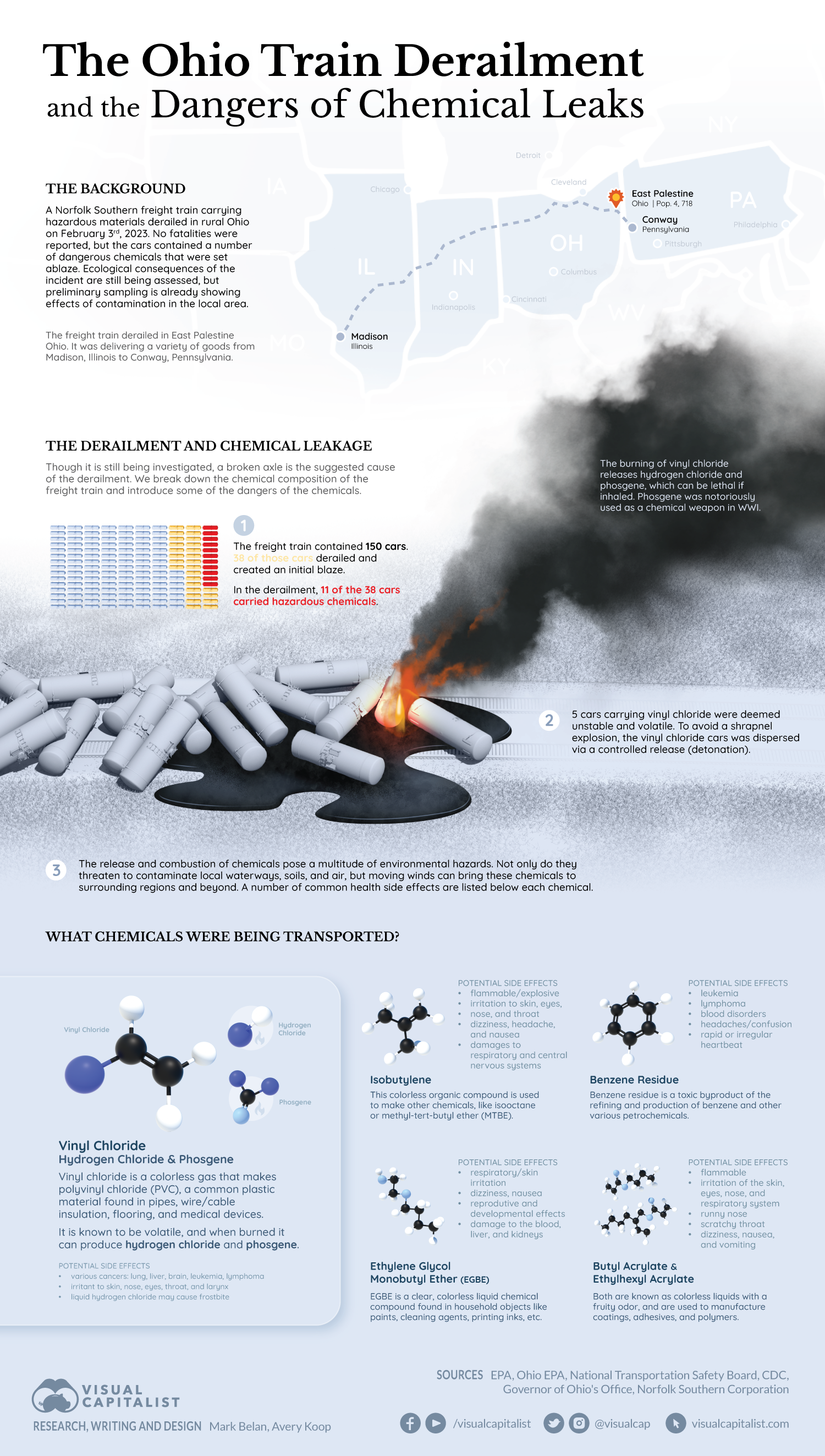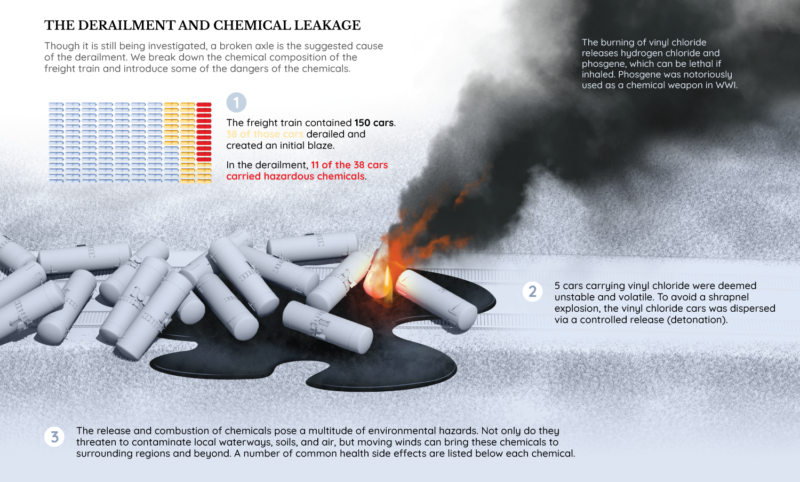
What started out as a seemingly commonplace train derailment near the border of Ohio and Pennsylvania in early February escalated into a serious threat to more than 4,000 people in the immediate area. Millions of people living in the vicinity of the derailment are also watching this situation closely as chemicals have made their way into the air and waterways.
This article was written by Avery Koop and originally published by Visual Capitalist.
Vinyl chloride, which was being transported on a number of the 150 train cars owned by Norfolk Southern, is a key cause for concern in the aftermath of the derailment. The chemical is a known carcinogen, and is dangerous when released into the environment.
In this piece, we’re providing a timeline, an explainer on the chemicals being carried by the train, the impact zone of the derailment and release of said chemicals, and the other basics you need to know.
What Was the Train Carrying?
The company that owns the train, Norfolk Southern, released a document detailing the train cars and what each carried, as well as whether or not it was damaged and/or derailed. Here are the highlights:
Aside from dangerous chemicals, the train was carrying things like sheet steel, semolina, cement, malt liquor, and paraffin wax.
The Threat of the Chemical Substances
- Vinyl chloride: a gas which is commonly used to make PVC plastics. It is extremely flammable and produces toxic fumes when burned. It is also carcinogenic and can cause a myriad of health issues.
- Butyl acrylate: a liquid used for making sealants, adhesives, and paints. It can cause skin, respiratory, and eye irritation.
- Benzene residue: benzene is a highly flammable liquid. It is used to make things like rubbers, plastics, and dyes. It evaporates extremely quickly into the air and if exposed at high levels, it can cause dizziness, unconsciousness, tremors, irregular heartbeat, among other symptoms.
- Ethylhexyl acrylate: a liquid used to produce plastics and paint. It can cause respiratory and skin irritation. It can also produce a hazardous vapor under appropriate heat.
- Ethylene glycol monobutyl: a liquid that is primarily used as a solvent for inks and paints, as well as dry cleaning solutions. It is acutely toxic and can inflict serious or permanent injury. Vapors from the liquid can irritate the nose and eyes, and, if ingested, can cause vomiting and headaches.
- Combustible liquids
According to the CDC, many of these substances are frequently transported across the U.S.; benzene, for example, ranks in the top 20 chemicals by production volume in the country.
The Timeline
Friday, February 3rd: The train, which was heading from Madison, Illinois to Conway, Pennsylvania, was carrying various products from frozen vegetables to industrial chemicals. Near East Palestine, Ohio, just before the Pennsylvania border, 38 of the train’s 150 train cars derailed and subsequent fires caused damages to another 12. Additionally, 11 of the derailed train cars carried hazardous material, the most dangerous being vinyl chloride.
The derailment caused a large fire and ominous plumes of smoke over East Palestine, but there were no fatalities or injuries. According to the National Transportation Safety Board (NTSB), the cause of the derailment is still under investigation.
Saturday, February 4th: Environmental Protection Agency (EPA) crews began running air pollution and water runoff tests. They detected contaminated water in two streams, Sulphur Run and Leslie Run.
Sunday, February 5th: The EPA and Norfolk Southern’s contractors continued testing, and recovery efforts were underway at the contaminated water sites.
Monday, February 6th: Responders conducted a controlled burn of toxic materials to destroy the remaining vinyl chloride, which posed a threat of explosion and subsequent toxic fumes and shrapnel. Because of this the standing evacuation order was extended to include a larger area. From the Ohio governor’s announcement:
“The controlled release process involves the burning of the rail cars’ chemicals, which will release fumes into the air that can be deadly if inhaled. Based on current weather patterns and the expected flow of the smoke and fumes, anyone who remains in the red affected area is facing grave danger of death.” – MIKE DEWINE
Wednesday, February 8th: Just days later, the governor announced that it was safe for residents to return home as air quality tests were coming back clean.
In the last week: Reports have been coming in of people feeling symptoms related to the release of toxic chemicals. Additionally, the Ohio Department of Natural Resources, reported that 3,500 fish were found dead in Ohio waterways as a direct result of the spill from the train derailment.
The EPA, however, has screened the air quality inside more than 400 homes, finding levels to be safe. A statement from the regional director of the EPA said that: “Since the fire went out on February 8, EPA air monitoring has not detected any levels of health concern in the community that are attributed to the train derailment.”
On Wednesday, the 15th, Norfolk Southern representatives pulled out of a meeting with town officials, causing outrage among residents. The following day, EPA administrator, Michael Regan, visited East Palestine to quell the anger and fears, but residents are still unhappy and skeptical of the testing.
The largest remaining issue is that water quality connected to the Ohio River, which is still being monitored. The governor has recommended only drinking bottled water.
The Overall Impacts
The town of East Palestine is home to just over 4,000 people and the crash happened dangerously close to the city of Pittsburgh, PA. Contamination in the water supply have led to the deaths of thousands of fish and people are now complaining of reactions to the chemical leakage.
Norfolk Southern has set up an Assistance Center and donated over $1 million to help people cover costs of evacuation, as well as conducting extensive testing of air and water quality. The governor is now calling for tighter regulations on rail companies and a number of lawsuits have been filed against Norfolk Southern.





